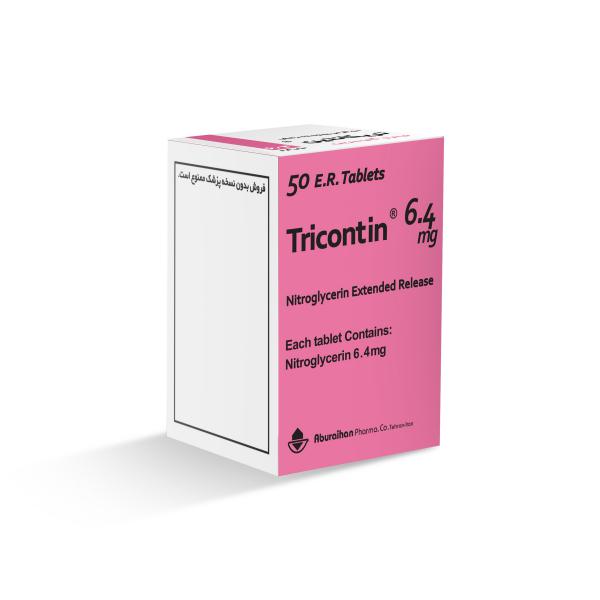Tricontin®
Nitroglycerin
Tablet
Treatment or prevention of angina pectoris
Mechanism of Action:
Nitroglycerin forms free radical nitric oxide. In smooth muscle, nitric oxide activates guanylate cyclase which increases guanosine 3’5’ monophosphate (cGMP) leading to dephosphorylation of myosin light chains and smooth muscle relaxation. Produces a vasodilator effect on the peripheral veins and arteries with more prominent effects on the veins. Primarily reduces cardiac oxygen demand by decreasing preload (left ventricular end-diastolic pressure); may modestly reduce afterload; dilates coronary arteries and improves collateral flow to ischemic regions. For use in rectal fissures, intra-anal administration results in decreased sphincter tone and intra-anal pressure.
Method of Administration:
2.6 to 6.4 mg 3 to 4 times daily; increase dose as needed based on response and tolerability to 26 mg 4 times daily. Include a nitrate-free interval of ~10 to 12 hours each day to minimize the risk of tolerance.
Notes
Contraindications:
Hypersensitivity to nitroglycerin, other nitrates or nitrites, or any component of the formulation
Interactions:
Anticholinergic Agents: May decrease the absorption of Nitroglycerin. Specifically, anticholinergic agents may decrease the dissolution of sublingual nitroglycerin tablets, possibly impairing or slowing nitroglycerin absorption. Risk C: Monitor therapy
Antipsychotic Agents (Second Generation [Atypical]): Blood Pressure Lowering Agents may enhance the hypotensive effect of Antipsychotic Agents (Second Generation [Atypical]). Risk C: Monitor therapy
Ergot Derivatives (Vasoconstrictive CYP3A4 Substrates): May diminish the vasodilatory effect of Nitroglycerin. Nitroglycerin may increase the serum concentration of Ergot Derivatives (Vasoconstrictive CYP3A4 Substrates). Management: Avoid the use of ergot derivatives in patients receiving nitroglycerin for angina (or in any angina patient) if possible. If combined, monitor for decreased effects of nitroglycerin and increased adverse effects of the ergot derivative (eg, ergotism). Risk D: Consider therapy modification
Heparin: Nitroglycerin may diminish the anticoagulant effect of Heparin. Nitroglycerin may decrease the serum concentration of Heparin. Risk C: Monitor therapy
Pregnancy and Lactation:
Nitroglycerin crosses the placenta. Based on its ability to produce smooth muscle relaxation, nitroglycerin may be used in obstetrical procedures when immediate relaxation of the uterus is needed, such as: uterine inversion following delivery
Is not known if nitroglycerin is present in breast milk, the decision to continue or discontinue breastfeeding during therapy should take into account the risk of infant exposure, the benefits of breastfeeding to the infant, and benefits of treatment to the mother.
Warning and Precaution:
- Headache: Dose-related headaches may occur, especially during initial dosing.
- Hypotension/bradycardia: Severe hypotension and shock may occur (even with small doses); paradoxical bradycardia and increased angina pectoris may accompany hypotension. Orthostatic hypotension may also occur; ethanol may accentuate this. Use with caution in volume depletion, preexisting hypotension, constrictive pericarditis, aortic or mitral stenosis, and extreme caution with inferior wall myocardial infarction (MI) and suspected right ventricular involvement.
- Increased intracranial pressure: Nitroglycerin may precipitate or aggravate increased intracranial pressure and subsequently may worsen clinical outcomes in patients with neurologic injury (eg, intracranial hemorrhage, traumatic brain injury
Adverse Reactions:
Cardiovascular: Hypotension (≤4%), peripheral edema (lingual spray: ≤2%), syncope (≤4%)
Gastrointestinal: Abdominal pain (lingual spray: ≤2%)
Nervous system: Dizziness (>2% to 6%), paresthesia (>2%)
Neuromuscular & skeletal: Asthenia (all sublingual forms: ≤2%)
Respiratory: Dyspnea (≤2%), pharyngitis (lingual spray: ≤2%), rhinitis (lingual spray: ≤2%)
Storage:
Store below 30ºC and protect from light and moisture.


